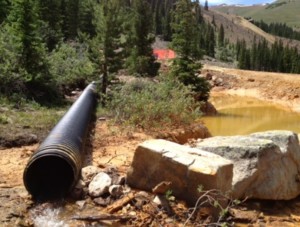Snake River Watershed Task Force
Case Study

Read the case study to learn more about how the group worked together to study the area and to implement collaborative cleanup activities, and the keys to success that surfaced along the way.
Background
The Pennsylvania Mine lies about 7 miles east of Keystone Resort, 4 miles from Arapahoe Basin Ski Area, 2 miles south of the twin 14ers Grays and Torreys, and just under the towering Continental Divide. Prospectors discovered silver in this area in 1864. In less than a century of digging up silver, gold, lead, copper and zinc and blasting apart rock that had barely moved for millennia, the miners left damage that will last an unknown number of generations. The Pennsylvania Mine, along with dozens of other nearby mine sites, adds toxic levels of heavy metals and acidifies the water flowing into Peru Creek, a tributary of the Snake River, which flows through the resort of Keystone into Dillon Reservoir.

Current environmental regulations require those conducting mining to repair damage to mountains and streams and address the production of acid drainage. But these laws don’t make it easy to clean up old abandoned mines, where those who caused the pollution are long gone and can no longer be held responsible. An unintended consequence of the Clean Water Act legislation is the extensive liability risks to agencies and environmental groups interested in doing water quality improvements — effectively preventing voluntary cleanups. In 2000, after years of studies on mining impacts to the watershed, a group of stakeholders formed the Snake River Watershed Task Force to collaboratively explore and implement the most promising strategies for reducing heavy metal concentrations.
Facilitated by Keystone Policy Center, the group included representatives from the U.S. Environmental Protection Agency (EPA); U.S. Geological Survey (USGS); U.S. Forest Service (USFS); Colorado Division of Reclamation, Mining, and Safety (DRMS); Colorado Department of Public Health and the Environment (CDPHE); Northwest Colorado Council of Governments (NWCCOG); Summit County Open Space and Trails; Trout Unlimited (TU); and local community members and ski areas. Task force members worked together over the course of two decades to improve conditions enough to create a sustainable fishery in the Snake River.
For more information on the Task Force, please contact Julie Shapiro, Senior Policy Director, Keystone Policy Center.
For more information about the Pennsylvania mine, visit the EPA Site Profile: Pennsylvania Mine.







 Login
Login



